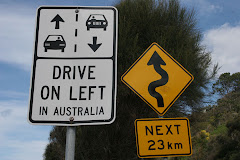Summer in Melbourne officially starts the beginning of December. Throughout this past December, we enjoyed mild days with a bit of rain here and there and an occasional peak in the mercury. Melbournians were commenting on how mild the summer was, but gut instinct told many of us the worst was yet to come. January came and went in the same kind of mild mannered way that December slipped by. Temperatures were warm, but the very hot days were few and far between. Enter February and the honeymoon period was finally over.
The first few days of February were marked with 40+ degree Celsius temperatures (that's over 100 degrees Fahrenheit) and Melbourne nearly came to a stand still. Historically, temperatures in Melbourne haven't been this extreme in the summer. During the 8 years that I've called Melbourne home, I can remember several instances of 38 degree temperatures or maybe even one or two 40 degree days, but never temperatures exceeding 40 degrees and never several of these days in a row.
Last week Melbourne experienced what local meteorologists are calling, "a once in a century heatwave". The extreme heat crippled this city for several days and there wasn't a single soul that wasn't adversely affected. There are plenty of locations around the globe that sustain these extreme temperatures for days, weeks and months on end and the people living in these regions seem to cope with the heat. Why is Melbourne so different from everywhere else?
I think the answer lies in the fact that historically, Melbourne hasn't been this hot. Which means that infrastructure hasn't been built with these extreme temperatures in mind, air conditioning of buildings and cars isn't standard, and native plants and animals aren't predisposed to coping with such intense heat.
Whilst it may have gone unnoticed by the international community, Australians are keenly aware that many parts of the continent are suffering from one of the longest droughts in the nation's history. Minuscule rainfall has created some of the driest conditions we've seen in Victoria and if you combine this with extreme temperatures and some gusty winds you get the perfect bush fire cocktail. Last week there were fires burning on the periphery of Melbourne that threatened power supplies and in some cases led to power outages.
On the final day of the extreme temperatures, daily life in Melbourne became chaotic as the stressed public transport system was forced to cancel hundreds of scheduled services due to the buckling of rail tracks and mechanical issues with the trains. Many small businesses closed up shop early as the streets were more or less empty as the city's population struggled to find ways to keep cool. Public swimming pools reached capacity and power outages created traffic snarls as a large percentage of the city's residents endured rolling stoppages. The multiple days of extreme heat were taking their toll on the city.
When the heat finally subsided and relatively cooler temperatures breathed life back into the streets and homes of Melbourne, it was clear the heat had left it's mark on our landscape. During the past week as I've driven around our local area, I've noticed the streets are littered with leaves from trees. At some point my mind was actually tricked into thinking we'd entered autumn because the landscape looked so brown and barren. Even the more drought tolerant plants we have planted in our back garden sustained damage from the laser like rays of the sun. Everywhere you look, the foliage is wilted, sadly sagging, and slowly drying up.
A "total fire ban" has been in place since the warm temperatures first hit our city. Looking around now, you can understand why. A stray cigarette butt could probably take out an entire suburb in the current conditions. It's a scary thought.
For those doubters of climate change and those who deny ozone depletion, I invite you to come to Melbourne and see the effects first hand. What is happening here simply isn't normal.
Rolex’s Enduring Love Affair with Tennis
1 week ago









1 comment:
Let us pray that the cooler weather is here to stay. You would never know that yesterday was 46+ degrees when today is a mere 20.
Post a Comment